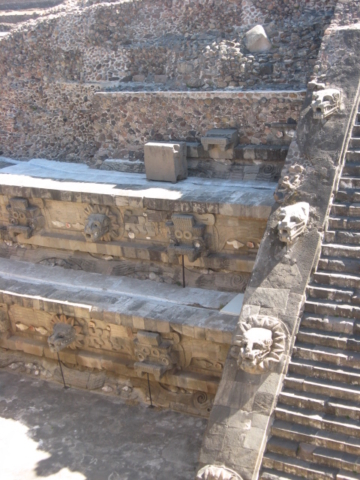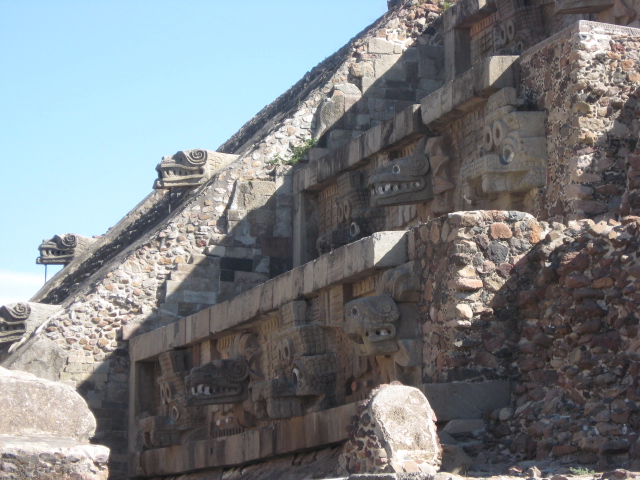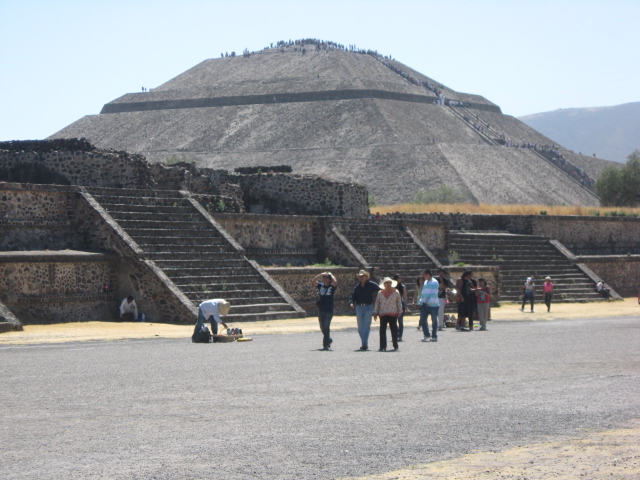
Ruta Maya – Part Two
Part Two of a series of articles about Central America’s Aztec and Mayan pyramids and ruins. Updated Sep 2022
Keep your room in Mexico City for another day. The ancient city of Teotihuacan (pronounced tay-oh-tea-wah-can) is located about an hour’s drive northeast of Mexico City. Teotihuacan is amazing. The only thing I could think of when I saw it was, “Wow!”
Teotihuacan is a City, not a Pyramid.
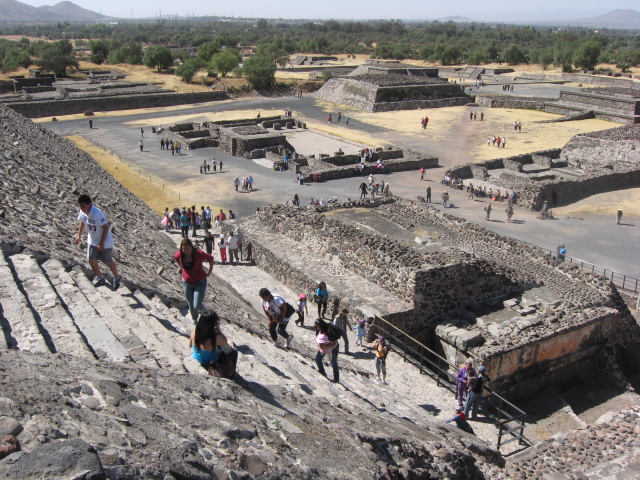
Teotihuacan is a huge city with massive pyramids like those in Egypt. There are two giant pyramids, one medium size pyramid, and so many small ones that I could not count them all. There are streets and walls and dozens of plazas. It is one of the most amazing things I have seen. I think it is the second best thing I have seen in my life after the old walled city of Jerusalem. Better than the pyramids in Egypt. You can see giant pyramids in Egypt, but they are just sitting out in the desert. Here there is a whole city.
Tourists overlook Teotihuacan on their way to Chichen-Itza.
Teotihuacan is overlooked by most foreign tourists, who head for the Mayan pyramids on the warmer south coast of Mexico so that they can see a pyramid between their days at the beach. Having said that, there were thousands of people there the day I went, but they were mostly locals, as Sunday is the day that Mexicans go out for a day trip. There were also people from all over the world. I heard people speaking English, Russian and other languages. I am not very good at estimating numbers of people, but there must have been at least five thousand.
Avoid going on a Sunday and go early in the morning to avoid crowds. Buses go to Teotihuacan from the Zocalo, but it is best to go by car to get there early and stay as long as you want. There were not many people when I first arrived in the morning. By noon, crowds filled the city. It is the most visited archaeological site in Mexico, but I believe that is due to its proximity to the millions of people in nearby Mexico City and not foreign tourists.
One of the Largest Cities in the World
The city was built about 200 B.C. There is a broad avenue called the Street of the Dead that stretches the entire length of the city. The size was initially 20 sq. km. More than 100,000 people lived here during its peak, making it the fifth or sixth largest city in the world about the year 450. However, overcrowding and lack of food became a problem, and people began to leave the city. By the 14th century, it was abandoned.
When the Spanish conquistadors came to Mexico in the early 1500s, they destroyed all the temples they found. However, probably because Teotihuacan was abandoned, the conquistadors did not find the city, and it escaped destruction.
The Citadel
Before going down the main street, go straight across to the Citadel as you enter the city into a large enclosed area. It has a large wall around it with four small pyramids on three sides. The fourth side, furthest from the road, has a medium-sized pyramid and the Temple of Quetzalcoatl.
The compound was the home of the important people of the city, such as royalty and priests. Walk up the wide stairway, over the wall, and down the other side into the Citadel. No houses or other buildings remain. On the far side of the compound is a pyramid called the Temple of Quetzalcoatl. There are two pyramids here; the first is right in front of the temple, almost touching it. The best view of the second pyramid is from the top of the first one. The first pyramid is without decoration, but the temple behind it is covered with carvings and gargoyles. The temple is 50 metres wide at the base. To dedicate the grand opening of the temple, 200 prisoners of war were killed here.
The Street of the Dead
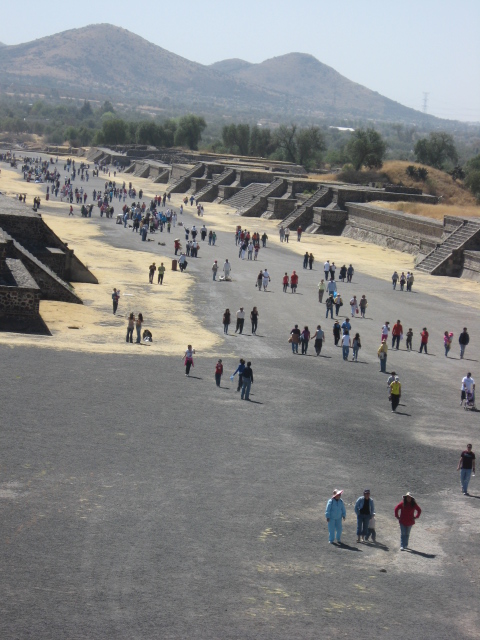
Leaving the compound, go back to the Street of the Dead. This wide avenue is lined with small pyramids. You can see a massive pyramid at the other end of the street, more than two kilometres away. The street is so named because it was thought Teotihuacan kings were buried in the pyramids along the side, but this is not the case. These small pyramids line the street on both sides for its entire length.
Every so often, the street lowers into a small plaza. If you are going straight, you need to go down the steps, across the plaza, and go up the steps on the other side. These plazas divide the city into something like modern city blocks or neighbourhoods, but a bit longer. Some of the plazas have structures in the centre. These were probably places for gardens, entertainment, speeches, and other non-religious activities.
Stone Walls
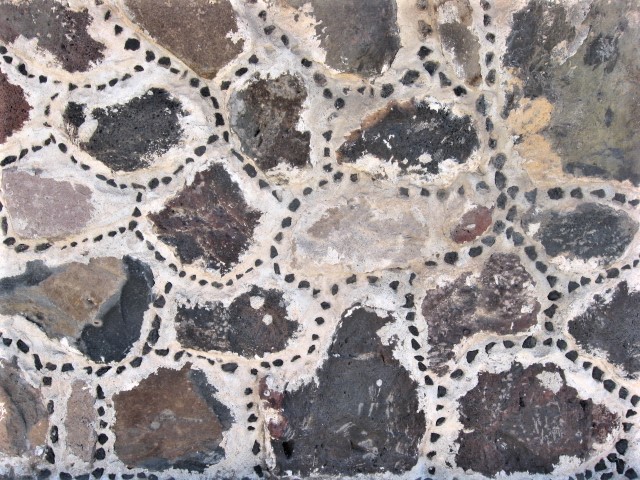
The walls of the street are made of stone. In between each large stone is a row of small stones. It is a simple but pretty design. At some point in time, the people decided to plaster over the original wall and paint it. However, most plaster is gone, and the walls are back to their original condition. In a few places, there is still some artwork on the walls.
Pyramid of the Sun
(Click photos to enlarge)
After walking for about one kilometre, past several plazas, you come to the giant pyramid known as the Pyramid of the Sun. It is 225 metres wide (746 feet) and nearly 65 metres in height (213 feet), similar to the great pyramids in Egypt. The largest Pyramid in Egypt is about the same size at the base but twice as tall. Mexican pyramids are the second and third largest in the world. The other pyramids in Egypt are smaller. Construction began about 200 B.C and was completed by 150 A.D. I climbed the pyramid, along with hundreds of other people. It is possible to walk around the pyramid at different levels. There is a spectacular view of the city from the top. There is a tunnel leading to the pyramid’s centre, but it is not open to the public.
Pyramid of the Moon
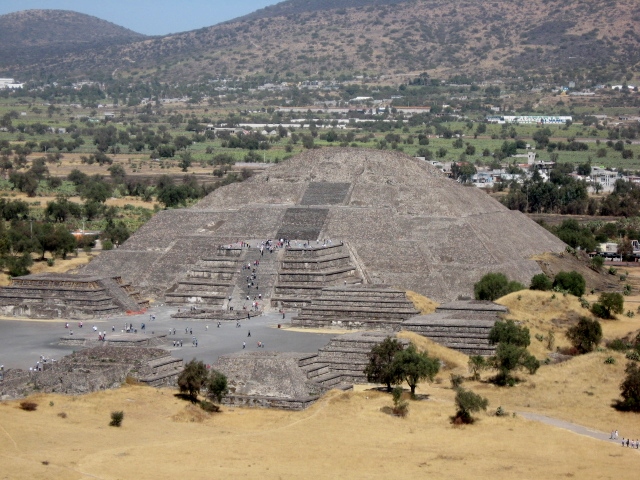
After returning to earth, continue walking along the Street of the Dead. At the far end of the street is a large plaza and another giant pyramid. This one is called the Pyramid of the Moon. It is a little smaller than the Pyramid of the Sun. It was built later, probably around the year 500. These pyramids once had elaborate temples on the top, but they are long gone. The movie “Tarzan and the Mermaids” was produced mostly in a lagoon near Acapulco, but the temple scene was shot at Teotihuacan.
After returning to earth, continue walking along the Street of the Dead. At the far end of the street is a large plaza and another giant pyramid. This one is called the Pyramid of the Moon. It is a little smaller than the Pyramid of the Sun. It was built later, probably around the year 500. These pyramids once had elaborate temples on the top, but they are long gone. The movie “Tarzan and the Mermaids” was produced mostly in a lagoon near Acapulco, but the temple scene was shot at Teotihuacan.
Plaza of the Moon
At the end of the street, just in front of the Pyramid of the Moon, is the large Moon Plaza with 12 small pyramids in this plaza alone, as well as the massive Pyramid of the Moon itself.
You need at least a whole day to see the city of Teotihuacan. I spent the day there and still did not see everything. Many people spend thousands of dollars on seeing the pyramids of Egypt. I have seen both, and I think Teotihuacan is the more impressive, although one pyramid in Egypt is taller, and they also have the sphinx there. If you are coming from Canada or USA, it is a lot cheaper than travelling to Egypt. A trip to Teotihuacan is worth coming to Mexico alone, even if you see nothing else. Teotihuacan was designated a United Nations World Heritage Site in 1987.
Second Visit 2018
I was so impressed with Teotihuacan, that I went back in 2018 for a second visit. This time I went during the week and not on a Sunday. There were a lot less people there. Hundreds instead of thousands. I find Teotihucan to be fascinating and would never get tried of visiting it.
Ruta Maya – other parts
If you missed part one of this series, click here.
For parts three to 17, click here.
